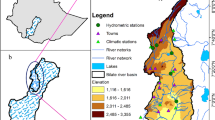Abstract
In this paper, the NAM model was applied in the Strymonas River catchment to simulate the daily discharge that ends up into the Lake Kerkini. In the NAM model, the catchment is represented by four reservoirs, each one representing different physical elements of the catchment. The model uses precipitation, potential evapotranspiration and temperature as driving forces in the simulation of snow accumulation and melting, interception, actual evapotranspiration, overland flow, interflow, groundwater recharge and baseflow. Optimal calibration of the model parameters was obtained for three different model setups by using meteorological and discharge data. The model was also validated against discharge data. The NAM model was used to estimate the continuous Strymonas River mean daily discharge and the results show that the estimation accuracy is depended by the model setup.
Access this chapter
Tax calculation will be finalised at checkout
Purchases are for personal use only
Preview
Unable to display preview. Download preview PDF.
Similar content being viewed by others
References
DHI (2009) MIKE 11: A modeling system for rivers and channels. Reference manual. Danish Hydraulic Institute, Denmark
Doulgeris Ch, Halkidis I, Papadimos D (2008) Use of modern technology for the protection and management of water resources in Strymonas/Struma River basin. Technical Report, Greek Biotope/Wetland Centre (EKBY). Thermi, Greece. 82 p
Gerakis PA, Tsiouris S, Tsiaoussi V (2007) Water regime and biota: proposed minimum values of lakes water level and of rivers discharge in Macedonia and Thrace, Greece. The Goulandris Natural History Museum/Greek Biotope-Wetland Centre, Thermi, Greece (in Greek, summary in English)
Halkidis I, Papadimos D (eds) (2007) Technical report of LIFE Environment project: Ecosystem based water resources management to minimise environmental impacts from agriculture using state-of-the-art modeling tools in Strymonas basin. Greek Biotope/Wetland Centre (EKBY), Thermi, Greece (in Greek, summary in English)
Hatzispiroglou J, Moussouliotis A, Zissis T, Anastasiadou-Partheniou E (2009) Application of the NAM rainfall-runoff model in hydrological basins of Samos Island. Proceedings of the common Conference of the 11th Hellenic Hydrotechnical Society and of the 7th Conference of the Hellenic Committee of Water Management. 229 - 236 (in Greek)
Keskin F, Şensoy AA, Şorman A, Şorman ÜA (2007) Application of MIKE 11 model for the simulation of snowmelt runoff in Yuvacik dam basin, Turkey. International Congress on River Basin Management, The role of general directorate of state Hydraulic works (DSI) in development of water resources of Turkey. DSI
Krause P, Boyle DP, Bäse F (2005) Comparison of different efficiency criteria for hydrological model assessment. Adv. Geosci. 5, 89-97
Madsen H (2000) Automatic calibration of a conceptual rainfall-runoff model using multiple objectives. J. Hydrol. 235, 276-288
Madsen H, Wilson G, Ammentrop HC (2002) Comparison of different automated strategies for calibration of rainfall-runoff models. J. Hydrol. 261, 48-59
Makungo R, Odiyo JO, Ndiritu JG, Mwaka N (2010) Rainfall - runoff modeling approach for ungauged catchments: A case study of Nzhelele River sub-quaternary catchment. Phys. Chem. Earth. 35, 596-607
Martinec J, Rango A (1989) Merits of statistical criteria for the performance of hydrological models. Water Resour. Bull. 25(2), 421-432
Mutreja KN (1986) Applied hydrology. Tata McGraw-Hill Publishing Company Limited, New Delhi
Papamichail DM, Papazafiriou ZG (1992) Multiple input - single output linear functional models for river flow routing. J. Hydrol. 133, 365-377
Refsgaard JC, Knudsen J (1996) Operational validation and intercomparison of different types of hydrological models. Water Resour. Res. 32 (7), 2189-2202
Shaw EM (1988) Hydrology in practice. Second edition, Chapman and Hall
Author information
Authors and Affiliations
Editor information
Editors and Affiliations
Rights and permissions
Copyright information
© 2011 Springer-Verlag Berlin Heidelberg
About this chapter
Cite this chapter
Doulgeris, C., Georgiou, P., Papadimos, D., Papamichail, D. (2011). Evaluating three different model setups in the MIKE 11 NAM model. In: Lambrakis, N., Stournaras, G., Katsanou, K. (eds) Advances in the Research of Aquatic Environment. Environmental Earth Sciences. Springer, Berlin, Heidelberg. https://doi.org/10.1007/978-3-642-19902-8_28
Download citation
DOI: https://doi.org/10.1007/978-3-642-19902-8_28
Publisher Name: Springer, Berlin, Heidelberg
Print ISBN: 978-3-642-19901-1
Online ISBN: 978-3-642-19902-8
eBook Packages: Earth and Environmental ScienceEarth and Environmental Science (R0)




